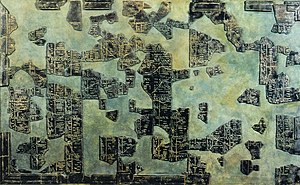Gaulish astrology and archaeoastronomy
Script error: No such module "AfC submission catcheck".
Both Greek and Roman sources attest to the study of the night sky by Gaulish druids. In Commentarii de Bello Gallico, Julius Caesar wrote that "[The druids] likewise discuss and impart to the youth many things respecting the stars and their motion, respecting the extent of the world and of our earth."[1] However, very little of what was known to the Celts have survived to the present. Research on Gaulish astrology and archaeoastronomy therefore requires extensive reconstruction from highly fragmented written sources and archaeology.
The Coligny Calendar[edit]

Gaulish knowledge of astronomy was sophisticated enough to construct a lunisolar calendar. The Coligny calendar, discovered in 1897 in Coligny, France consists of a 62-month cycle of five years: three "common years" and two leap years with extra months inserted into them. The Lunar months, which are 29 or 30 days long, are labelled "unlucky" and "lucky" respectively. The first half of the month always has 15 days; however, the second half may have either 14 or 15 days depending on the month length. This two-fold division of months (albeit without the shortening of odd-numbered months) is also found in lunisolar Hindu calendars such as the Vikram Samvat.[]
According to Pliny the Elder, the Gauls began months on "the sixth day of the moon". Steinrücken (2012) has proposed that assuming the leap month of every 30th year was dropped to prevent seasonal drift, then the delay in beginning the lunar calendar implies the creation of the calendar to the 11th century BCE.[2]
References[edit]
- ↑ Caesar, Julius. Commentaries on the Gaulish Wars. Book 6, Chapters 13-18. Retrieved 31 January 2022. Search this book on

- ↑ Burkard Steinrücken, (2012), Lunisolarkalender und Kalenderzahlen am Beispiel des Kalenders von Coligny pp. 7, 19.
This article "Gaulish astrology and archaeoastronomy" is from Wikipedia. The list of its authors can be seen in its historical and/or the page Edithistory:Gaulish astrology and archaeoastronomy. Articles copied from Draft Namespace on Wikipedia could be seen on the Draft Namespace of Wikipedia and not main one.
